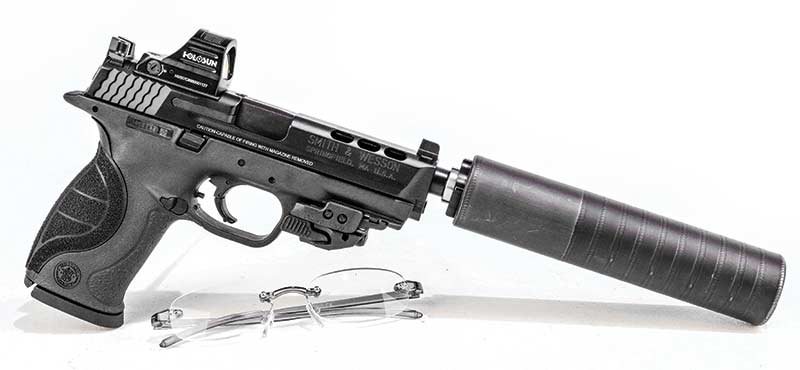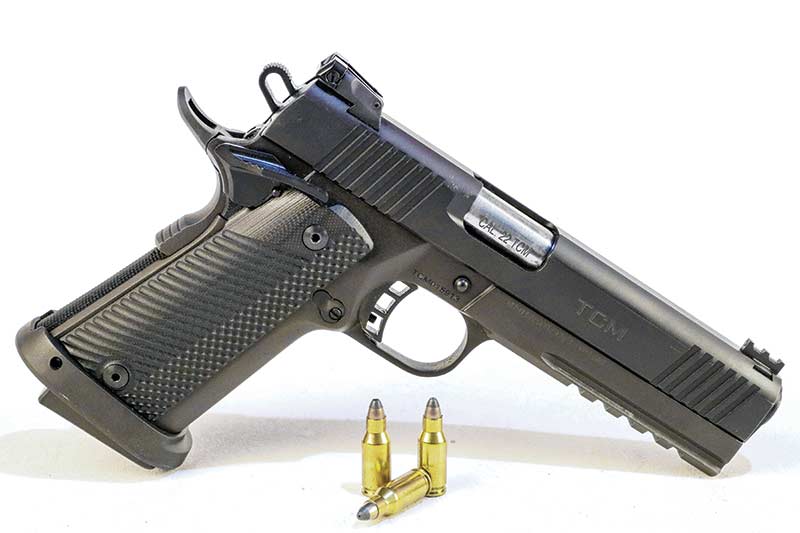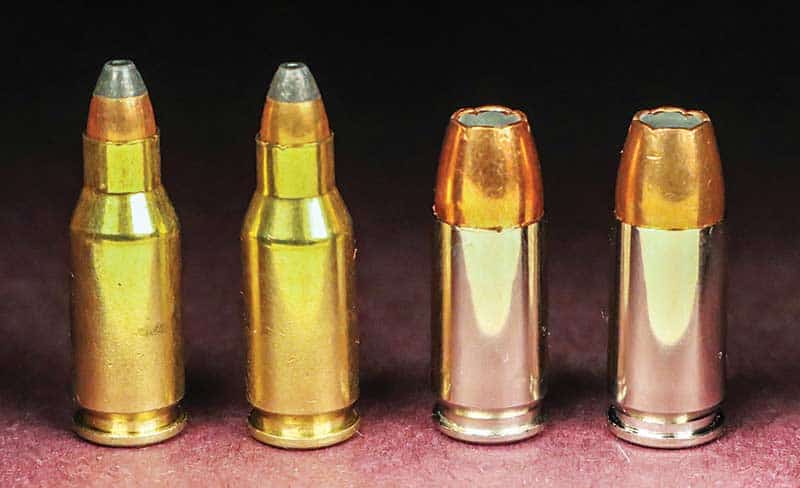Category: Fieldcraft
 AP —
AP — A man has died in the US state of Virginia after a bear in a tree, shot by one of his hunting partners, fell on him, state wildlife officials said.
The incident occurred on December 9 in Lunenburg County, which is between Richmond and Danville, Virginia’s Department of Wildlife Resources said in a statement.
A hunting group was following the bear when it ran up the tree, the department said. As the group retreated from the tree, a hunter shot the bear. The animal fell onto another hunter, who was standing about 10 feet (3 meters) from the bottom of the tree.
The department identified the dead man as Lester C. Harvey, 58, of Phenix, Virginia. A member of the group rendered first aid before Harvey was rushed to two different hospitals. He died from his injuries Friday, the wildlife department stated.
An obituary for Harvey, a married father of five with eight grandchildren, said he was a self-employed contractor and avid outdoorsman.
Similar incidents have occurred in recent years.
In 2018, a man in Alaska was critically injured after his hunting partner shot a bear on a ridge. The animal tumbled down a slope into the man, who was also struck by rocks dislodged by the bear.
Another man was injured in 2019 after his hunting partner shot a bear in a tree in North Carolina. The bear fell out of the tree and began biting the hunter. The man and the animal then tumbled off a cliff. The hunter was taken to a hospital, while the bear was later found dead.
I Broke My Hand
How far is TOO FAR?!
Opinion

What is more frustrating than myths that get passed around with such regularity when no one pauses long enough to examine whether or not they are true? Maybe a case of the shingles, but other than that…
It won’t happen to you:
“Who cares?” you might think. “It’ll never happen to me.” You’re right, it probably won’t. However, there are one heck of a lot of burglaries every year. Since “home invasion” isn’t a named crime, statistics are difficult to obtain. A “home invasion” can be a burglary. It can be an assault, It can be an armed robbery. It can be rape or murder. You get the idea. Since there is no specific tracking for violent home invasions, we have to look at the associated crimes. Depending on the year and source, consider these figures.
- There are between two and nearly four million burglaries every year in the United States.
- In about a million of these cases, someone is home when the intruder breaks in.
- Over a quarter million people become victims of a violent assault associated with a home break-in.
That’s a lot of action. That’s as many as 10,958 self-serve home-entries each and every day. Or, you might think of it as almost eight per minute.
Oh, one more interesting tidbit. While most people assume that nighttime carries the highest risk of a home invasion, most incidents occur between the daylight hours of 10am and 3pm. Food for thought for your overall home security plan. Lock those doors during the day too!
A laser will just give away your position:
I can’t count how many times I’ve heard this myth repeated. I think it persists because there is a nugget of largely irrelevant truth to it. There are a few things to consider before discounting the value of a laser sight on your home defense firearm.
First, are you planning to play a game of “Ninja find the other ninja” in your home as part of a defense plan? If your primary use of a firearm involves sneaking through dark villages and buildings so you can kick down a door and kidnap someone, then this myth is valid. A laser probably will give away your position. If your use case involves defending yourself and family from someone breaking into your home, you might want to reconsider your tactical plan if it involves you sneaking around playing cat and mouse with a band of tactical commandos who are going room to room looking for you. I’m sure there’s an example of a highly trained Delta Ninja Seal Omega Sector Assault Team planning a nighttime attack on one of our suburban homes, but the vast majority of cases are better resolved by hiding in place, armed and ready, while calling the police for backup.
As an industry acquaintance once said, “A laser won’t give away my position. What will give away my position is me yelling something to the effect of, ‘Get out of my house before I shoot your sorry @ss!’”
Second, laser beams are largely invisible. Unless your home is full of smoke or fog, all that’s visible is the light on the firearm itself and the dot on the target. With rare exception, the beam in between doesn’t show. Give it a try.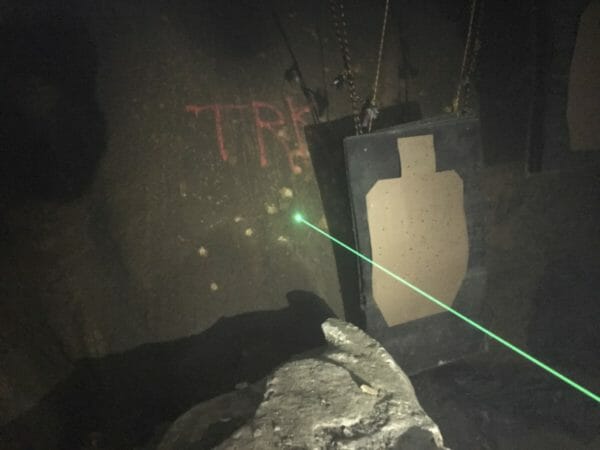
Fourth, before you pull a trigger in your home in the middle of the night, you’d better be darn sure of what you’re shooting at. That means either there’s enough light so you can see your target (which means they can see you) or you’re using a light of some sort. A laser isn’t going to be the thing that reveals your presence.
I poke some fun at this myth, but it’s a serious topic. I don’t care if you choose a laser or not. What I care about is the ability to get shots on target as fast as possible in poor light conditions and from unconventional positions that tend to happen in a self-defense scenario. I’ve not found anything more effective than a laser at making that happen. Your mileage may vary.
Racking a shotgun slide:
Is this one a myth or not? I’ve not yet found any volunteers to break into my house at night so I can rack an 870 to see if it freaks them out.
For the rest of the cases, I suspect we can also agree that it would be a great outcome if that racking sound ended the potential confrontation. Just don’t count on it. Be prepared for more, especially now that the intruder knows you’re home and armed.
Don’t use an AR-15 because it will over-penetrate:
An AR-15-type firearm can actually make a great home defense weapon. As with most things, the devil is in the details when considering penetration issues.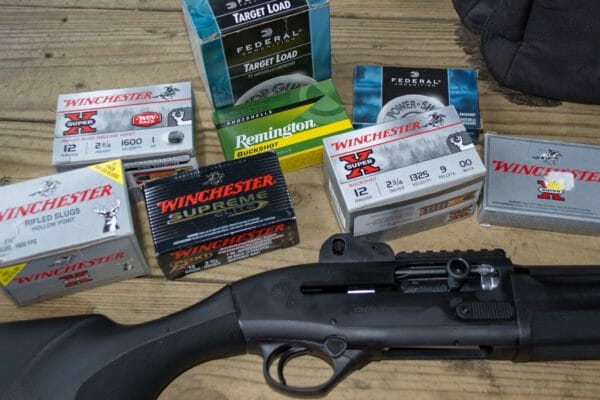
I hear lots of people say things like, “I use a shotgun as I don’t want to worry about over-penetration.” That may or may not be a valid plan, depending on the choice of ammo. Having shot through lots of scrap drywall in range tests, I can tell you that buckshot penetrates walls just like handgun bullets. That means it’ll go through lots and lots of them. After all, a 00 buckshot pellet is more or less a .32 caliber handgun bullet but usually moves significantly faster at 1,500 or 1,600 feet per second. Of course, if you go to smaller shot sizes, like bird-appropriate pellets, penetration risk will be greatly reduced, as it will on human targets at ranges past a handful of yards. Don’t get me wrong, I’m not knocking shotguns for home defense. It’s hard to argue with terminal effectiveness. We’re only talking about over-penetration here.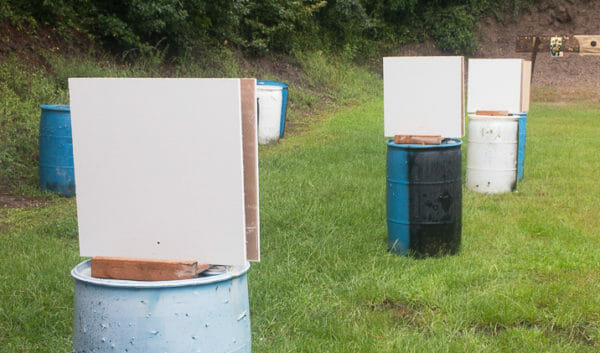
Surprisingly, standard 55-grain FMJ and varmint ammo penetrates less than almost all buckshot and handgun projectiles. Although those little buggers are fast at near 3,000 feet per second, they’re light and tend to break up and tumble after hitting barriers. Usually, the first and second drywall sheets start the upset and veering off course. By the third and fourth, things are getting wonky. Make no mistake, they’ll easily travel through multiple sheets of drywall, just fewer than other types of handgun and shotgun ammo.
Help is on the way in minutes:
As an AmmoLand News reader, you know the harsh reality of logistics. You’re the first responder to an event in your home. As committed as the local police may be, they’re always going to be the second responder.
Nationwide, the average police response time to arrive at the location of a call for help is about 10 minutes. Of course, that is the average of rural and urban environments. If you live in or near a city, your response times may get as low as four or five minutes. For example, in San Francisco, where you need a police response because you’re not to be trusted to protect yourself, it will take just under six minutes on average. Other big cities like Dallas, Los Angeles, and New York range from about six minutes to just under 10.
Here’s the problem. The average self-defense encounter goes from zero to “significant results” in about 90 seconds, again on average. So, no matter where you live, you’re not getting help in time to stop anything from happening. But you already knew that, right?
You’re more likely to get killed if you have a gun in the house:
We might as well end with a doozy. The anti-gun crowd loves to share a “statistic” like this one:
“If you have a gun in the home, you’re three times more likely to get killed.”
This little fake news tidbit that just won’t die comes from a study by Dr. Arthur Kellermann. After years of stonewalling his data and methodology, a couple of things came to light. First, he only counted homicides, where the homeowner died. He didn’t study how many lives were saved by the presence of a gun. Considering that 92% of defensive gun uses don’t involve a shot being fired, that’s a big deal. So, by not including no-shoot scenarios and those where the homeowner didn’t die, he cherry-picked about one percent of data to arrive at his conclusions. Oh, and then it was discovered that he also counted homeowners who were killed by guns that were NOT in their homes prior to the attack. Meaning if a home invader came in with his back street special and killed someone, that went into his tally.
Excellent science there, buddy.
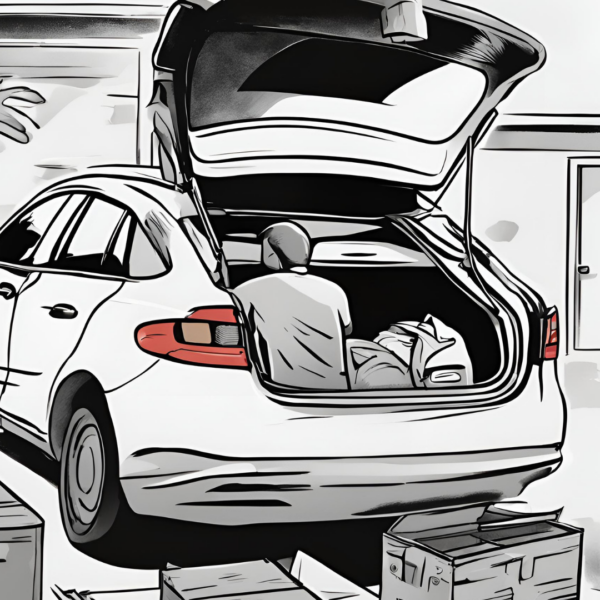 Okay, boys and girls, this is one of those semi-complex scenarios where you can hardly tell the players without a scorecard, so let’s make up some names and jersey numbers right now. First, there’s Paul Brite, a 53-year-old Florida businessman.
Okay, boys and girls, this is one of those semi-complex scenarios where you can hardly tell the players without a scorecard, so let’s make up some names and jersey numbers right now. First, there’s Paul Brite, a 53-year-old Florida businessman.
Like a lot of law-abiding Americans, Paul doesn’t care for the idea of becoming a crime statistic, knows that food doesn’t really come from grocery stores, and safety doesn’t emanate like a forcefield from police stations.
He’s got a valid CCW permit but doesn’t even pack a roscoe on his person, preferring to simply keep a sidearm handy.
Second comes Carl Lee “Brains” Reese, a 21-year-old self-made punk with multiple arrests for carjacking in two states and a lonesome parole officer wondering where the heck ol’ Carl’s gone off to.
Third in the lineup is Mario Danele “Wheels” Sikes, Reese’s cousin and apparently his biggest fan. At 17 years old, Sikes’ juvenile record is protected from our prying eyes, but he’ll soon be batting in the big leagues, the “Big House” leagues, anyway.
Then you’ve got Jim Haire, owner of a painting and decking business, who probably never pictured himself as a traffic controller, especially in the middle of a gunfight. The rest of the mob can be introduced as we move along.
It’s your basic sunny morning in Coral Springs where one Paul Brite is showered, shaved, and just finished running his Lexus through the neighborhood car wash. All seems absolutely hunky-dory until he is engaged in intense conversation by Mssrs. Reese and Sikes, one of whom holds a handgun to Brite’s attentive head.
A short time later, having covered about a mile, Reese turns onto a quiet side street and stops, apparently voicing some concern to his cousin that they may have screwed up mightily and locked their victim in the trunk with a cellular phone.
They agree to open the trunk and investigate Brite’s communications potential. Reese makes the move while Sikes resumes his station wagon navigator spot.
It seems that, no, they didn’t lock Brite in with a carphone, but the briar patch they threw him into happened to be where he keeps a loaded revolver and an equally stuffed semi-auto pistol, which he now holds, one in each hand, as he exits the trunk like a jack-in-the-box.
Two-Gun Paul bursts out of the trunk, loudly ordering “Brains” Reese to the ground, punctuating his commands with a few shots fired in the air. This definitely gets attention throughout the neighborhood.
Reese, no rocket scientist, greets this edict by reaching for his pocket. Brite reluctantly but resolutely pops a cap in Reese’s abdomen, which, indeed, convinces him to get on the ground.
“Stay still! Stay still!” Brite shouts, “Somebody get the police!” Reese, mortally wounded, stays very still.
And then The Little Rascals arrive. A flock of residential ragamuffins starts circling the still-energized Brite and recumbent Reese on their bicycles. Enter Jim Haire, on the run.
Waving his arms and shouting at the TV-trained kids, Haire bravely tried to convey the message that this was not a video game, boys and girls, and real bullets may re-commence flying momentarily.
Meantime, “Wheels” Sikes fires up the geriatric wagon, puts the pedal to the metal, and tries to play Lawnmower Man on both Brite and Haire.
Brite, dancing around so as not to place the street urchins in the line of fire, responds with another fusillade of hot lead, ventilating the Vista Cruiser but missing Sikes, who then decides to exit rapidly stage right, weaving through the flying circus of bicycles.
As the credits roll, we find the kiddies miraculously okay, Reese declared dead at North Broward Medical Center, Sikes taken into custody a short distance away, Haire wondering how he ever got into this melee and Paul Brite, a law-abiding citizen, miraculously not charged with violating the rights of his carjacking kidnappers.
Brite and Haire take justified bows. Sikes takes the rap for theft, kidnapping, and felony murder — for participating in a felon.
Mark Moritz hung up his satirical spurs last issue to a collective sigh of relief from America’s gunwriters whom he had lampooned in “Friendly Fire” for two long, painful years. The 10 Ring is written by Commander Gilmore, a retired San Diego police officer who bases his humor, like Mark did, on actual occurrences. All the incidents described by the Commander are true.
The scientific term is entropy. This is a quantifiable measure of the amount of disorder in a system. Everything naturally descends into a greater state of entropy. This simply means we inevitably get old.
Aging is not for sissies. Mundane things like turning my head when I back up the car can now be an ordeal. A foolish youth, spent relentlessly driving my body, has taken its inevitable toll. Now past the half-century mark I have come to appreciate there are some serious considerations when you wish to remain prickly after a Certain Age.
Fitness And The Physiology Of Aging
As we age our bones become brittle and we lose muscle mass. This leaves us more susceptible to younger, stronger predators. However, it doesn’t mean we have to just roll over and die. We can still mitigate these effects.
Keep your machine properly maintained. This means eating sensibly and avoiding tobacco and alcohol. Being out of shape is typically a choice. Eat the right stuff and in reasonable quantities.
With each passing year it gets tougher to stay lean and hard. My long-suffering knees won’t let me run, but my wife and I walk vigorously for an hour four days a week. It’s great fellowship.
An old back injury keeps me from doing pushups. I therefore did a perfect pushup on a bathroom scale and put the same weight on a bar. Now I can knock out my daily regimen via bench presses without stressing my back.
Most people eat a light breakfast, a modest lunch, and a massive supper but we have it all wrong. We are designed to eat a generous breakfast, a modest lunch, and minimal supper.
Staying strong and hard is still attainable in your later years but you have to want it. Keeping fit is a lifestyle. There are many aspects of aging over which you have no control but this is not necessarily one of them.
Eyesight
It’s called presbyopia, and I hate it. As you age the lens in your eye stiffens. This means most older people can no longer focus up close. My reading glasses are now an unfortunate part of my wardrobe. The really sucky bit is I can no longer clearly see my sights.
I cannot approach the degree of precision I enjoyed in my youth. However, there are tools to help overcome these disabilities. Electro-optical sights are the great equalizers.
Most everybody makes combat handguns with slide cutouts for a micro red dot sight nowadays. My favorite comes from Holosun. Holosun sights incorporate small solar cells along with conventional battery power. This dual-fuel design offers just stupid-long run times. Holosun sights are the only red dots in the collection I intentionally leave on all the time. It takes a little experience to bring the optic into your line of sight without conscious thought but it’s not like practicing with a gun is actually work.
Arthritis And Armaments
The joint pain associated with arthritis is a natural — though sucky — aspect of aging. This makes it tougher to jack the slide on a handgun. Working the action of a Desert Eagle is butt-whooping for a 20-year-old. As we get older even a GLOCK can become a challenge.
The 9mm Walther CCP sports a novel reverse gas piston design offering a very mild racking force. The 1911 pistols in .22TCM from Rock Island Armory are also comically light to charge. Some pistoleros will poo-poo the idea of carrying a gun throwing a tiny 40-gr. JHP bullet at 2,000 feet per second for defensive purposes. I’d be willing to bet those skeptics have never been shot with one.
Injury
As we get older our skin thins. Many seasoned Americans take blood thinners as well, even if it is just aspirin. This means you could be quick to bleed … a lot.
If you get hurt just put pressure on the wound as soon as the tactical situation allows. A typical healthy adult human has about five liters of blood. Lose one liter in 20 minutes and you get woozy. Two liters can be lethal. However, this amount is a lot of blood. Don’t freak out about it.
If you hit your head substantially you need to report to an emergency room, not a clinic. You’ll need a CT scan to rule out a bleed, and you usually cannot get one at your local urgent care. Take significant head injuries seriously, particularly in older people.
Be wary, treat your body respectfully, train hard and regularly, and choose your hardware carefully. Everybody gets old, but it doesn’t mean you have to do so gracefully. By properly maintaining your machine and packing the right iron you can remain tactically viable well into your golden years.
Attacking the Neck for Restraints, Takedowns and Chokes
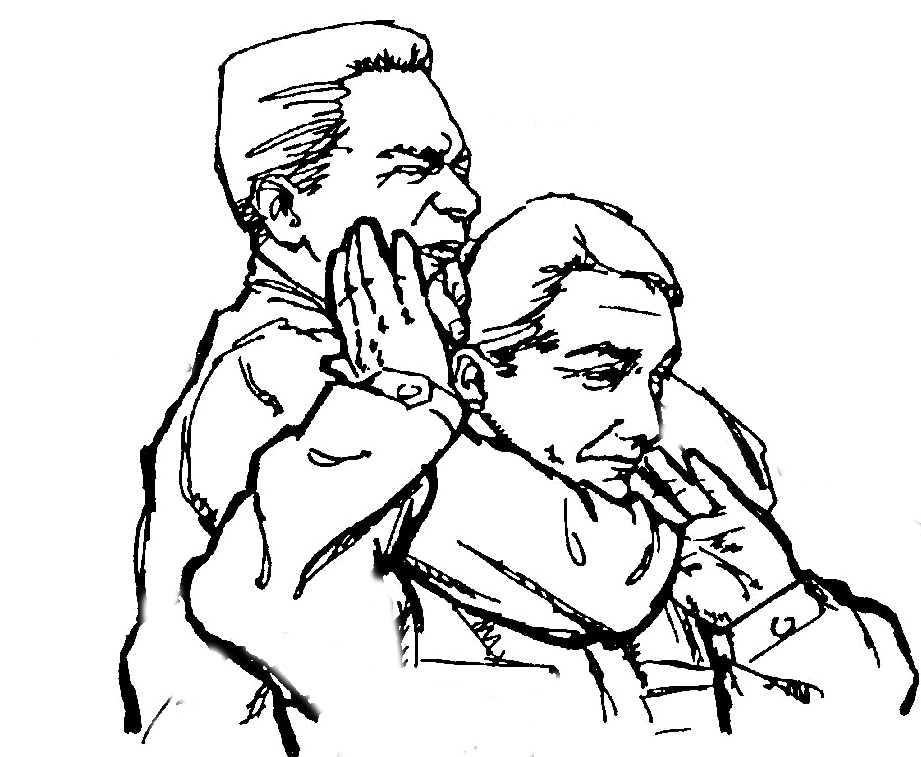
A martialist must have a working knowledge about the anatomy, physicality and the law when it comes to wrapping arms around the neck for any reason, a walk-away, takedown and/or any choke. Here is quick, mandatory report on what you should know on the subject in general.
First, I would like to establish my anecdotal experience. I am from an era, starting in the 1970s in martial arts and police work where chokes were very popular and roughly trained. A choke was a go-to, common enforcement move and in 26 years I have choked out about 10-12 or so people. That is not a lot, As an obsessive martial artist, training and experience has helped me use alternatives to choking. But I have witnessed and partaken in some 40 or more. Every suspect quickly recovered as we were taught to monitor the suspect’s responses. And I have been attacked by a few chokeholds, most during during arrests (read on for the worst). And in those olden training times, it was not uncommon to be accidentally choked out (and knocked out) sometimes in class. Times have changed.
Chokes were treated very flippantly in those olden times. Sadly, in the recent decades that followed, for whatever reasons – be they a lack of knowledge-training, etc., simple chokes have caused damages and deaths that have enraged into socio-political, national and international uproars.
You do not want you or your students, compatriots and-or employees to be a part of such uproars. Results may include imprisonment these days, by ignoring the facts. Chokes are risky yes, but, still, a martialist must have a working knowledge of chokes and non-choke, neck grabs.
While such sport-choke and related sport neck takedown methods are useful to practice and know, they are small in comparison to self defense, crime, law and war problem-solving. So, this subject-study will include civilian, enforcement and military realities, as well as generic, applications of arm wrap, chokes and neck grabs.
Due to popularity and fandom of martial arts sports, most of the neck-related, training attention, time-hubris is spent on sport tap-out chokes down on the mats to win matches and pro fights. This sports version eats up “all the oxygen” (if you will pardon the pun) in youtube videos and internet searches. Several martial arts will claim there are “100s” of chokes, but no. Instead, there might be hundreds of chess-like approaches and situations to inch into these chokes. The choke itself is “checkers simple.” Blood and air.
And important – all neck attacks are not chokes…however, neck attacks are loosely, flippantly called “chokes” or “chokeholds” by many. We’ll be looking at the common arm-related ones not crushing-hand chokes, but crushing hand chokes might cause similar injuries as arm wraps.(It should also be noted here that choking by the hands not arms is a very big domestic violence problem. That’s another essay. But generically speaking, the injuries are very the same.)
The big two… for our rear arm wrap attack and takedown essay and yes – as well as grounded problems, here are two main neck arm-wrap-grabs for rear chokes and takedowns. See the drawings below, single arm and double arm wraps. You will find there are numerous nicknames for chokes. Some do help identify the move-position. Blood chokes are often called “sleepers” because the “chokee” thinks he is really just neck-uncomfortable and still okay… and… and… he’s out. While an air choke will probably cause the chokee to “air swim,” like he is drowning on dry land.
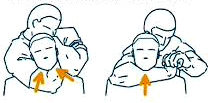
What are the legal and medical definitions? Law Insider defines a neck restraint as “the use of any body part or object to attempt to control or disable a person by applying pressure against the neck, including the trachea and-or carotid artery with the purpose, intent, or effect of controlling or restricting the person’s movement or restricting the person’s blood flow or breathing, including chokeholds, carotid restraints, and lateral vascular neck restraints.” (For the record, a “Lateral Vascular Neck Restraint® (LVNR®) is a control technique applied to the sides of the neck, using a combination of physiological factors to restrict blood flow to the brain which may cause the subject to lose consciousness.)
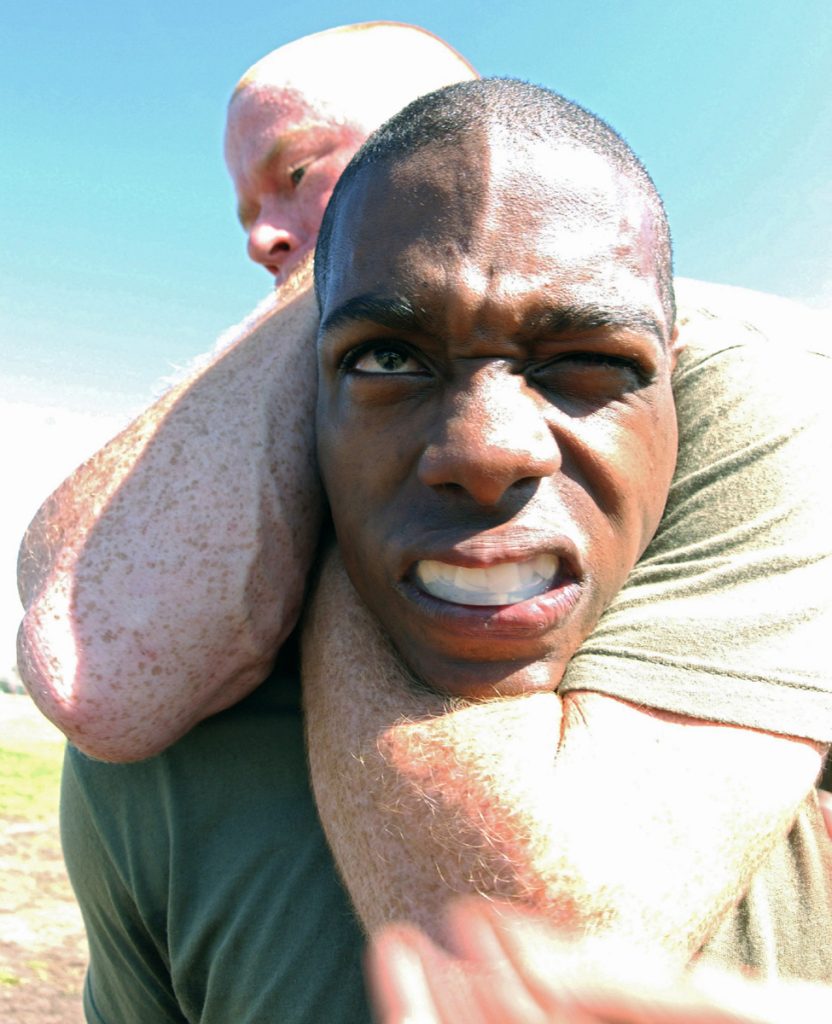
Dr. Google defines choking as a strangulation. “Strangling cuts off the flow of oxygen to the brain in one or more ways. Strangulation compresses the carotid artery or jugular veins, resulting in cerebral ischemia. Cerebral ischemia is caused by disruption of the blood supply, and thus oxygen, to the brain, particularly the cerebrum. Global ischemia is caused by cardiac arrest, shock, carotid occlusion,hypotension, asphyxia, or anemia. Focal cerebral ischemia is usually related to cerebral vascular atherosclerosis. Strangulation is defined as asphyxia by closure of the blood vessels and/or air passages of the neck as a result of external pressure on the neck.”
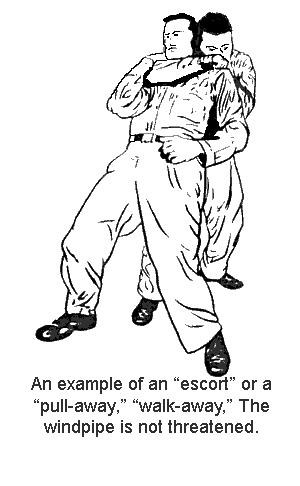 Non-choke neck grabs, restraints and takedowns can look like attempts at unconscious choking, but can be just temporary control measures. You can just remove-escort or takedown people via the neck area without choking them. Or you can follow up a takedown that includes a choke. With your decision to squeeze-choke the neck, your legal and medical strangulation clock is ticking…
Non-choke neck grabs, restraints and takedowns can look like attempts at unconscious choking, but can be just temporary control measures. You can just remove-escort or takedown people via the neck area without choking them. Or you can follow up a takedown that includes a choke. With your decision to squeeze-choke the neck, your legal and medical strangulation clock is ticking…
Tick-Tock…. In May, 2023, a former U. S. Marine interrupted a disturbance and threats on a New York City subway with a choke, one that according to witnesses the hold lasted 15 minutes. The person died. The Marine disputes the time length and denies lethal intent, but nonetheless the man died. This caused a serious socio-political incident and put the Marine under indictment for murder. One must be very cautious when doing any neck wrap choke-contact for criminal and civil problems. Did a restraint slip into a prolonged blood choke or an air choke? Did the hold last too long?

Very Well Health reports that, a “A medical evaluation is crucial if someone’s been strangled. An injury to the trachea may not appear to be serious right away, but swelling in the tissues around the trachea can lead to a secondary restriction of airflow a few minutes after the neck is free.”
So how long can you squeeze? Police files report officers that have blood-choked suspects held for 30 seconds have died. That’s a short time. But shorter times are on record. There are other times the suspects hang on, struggling for longer. The old and general advice with a blood choke is to monitor the opponent. You can feel when someone “goes to sleep.”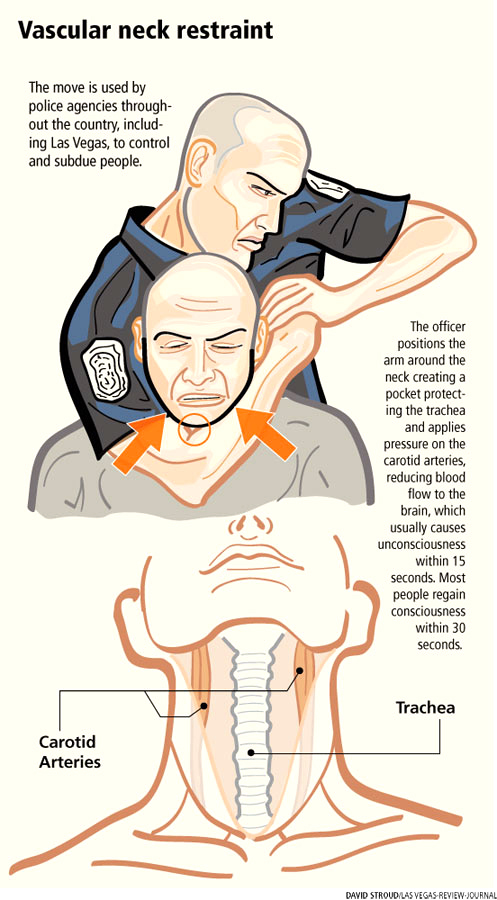
How long is long then? “A 17-member panel of submission experts (including BJJ black belts, experienced grapplers, former MMA athletes, and medical professionals) analysed 81 UFC matches between 1993 and 2020 that ended in strangulation submission due to a LOC (as opposed to tapping). Each examiner reviewed each film (blinded to the other’s interpretation) to determine the time between full application of the technique and LOC. The mean time to LOC was 9.0 seconds, with a standard deviation of 2.5s. (Note: this had to have included ground chokes and this section of Level 2 takedowns is only covering standing rear arm wrap chokes. Still we can glean related information.)
These results were consistent with previous studies in compliant volunteers, indicating that skillful application of a choking/strangulation technique will cause LOC regardless of defense mechanism…the triangle choke (probably down on the mat) displayed a significantly faster time to LOC of 7.2 seconds.” – Sam Gilbert
Crushing the trachea can cause death. There are incidents on police records of officers who are relatively untrained in this subject matter and they have accidentally crushed the trachea. The damage can range from minor vocal cord weakness to fractures of the larynx or trachea. These fractures can cause air to escape into the neck and chest, leading to significant respiratory compromise and even death if not treated quickly.
Basic neck structure injuries too… As I have mentioned not all neck-related, rear pull takedowns involve blood and air restraint, choke-to-unconsciousness intent. In terms of using the neck for takedowns and counters, in some cases you must worry about damaging the neck skeletal structure. But non-chokes are not without some medical, legal and civil law dangers.
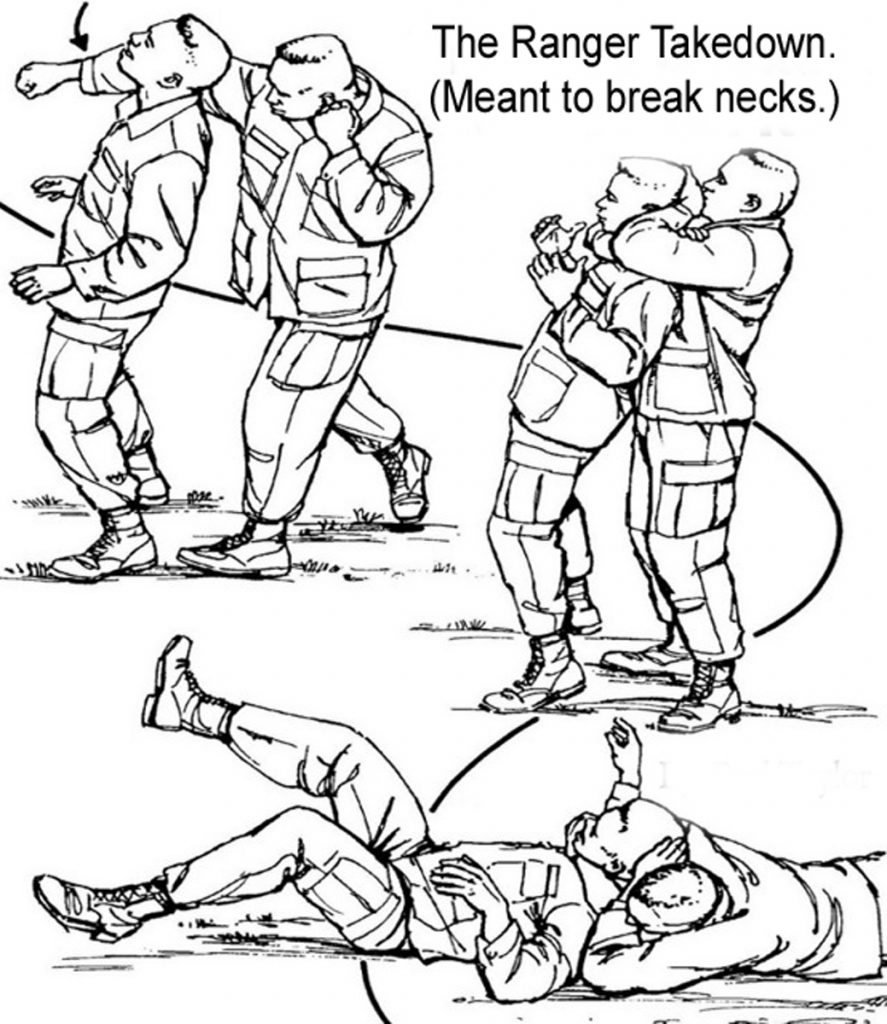 The most damaging neck takedown I have seen and had done on me, thankfully incorrectly, is what was once called the “Ranger Takedown.” In the remote northern areas of South Korea, a criminal Army Sergeant snatched up my throat from behind with a single forearm across my neck and jumped back, as diagrammed here to the left. In the taught move, the Ranger lands on his chest. The enemy soldier lands on his back. Neck? Snapped or very badly broken. I landed instead down on my side, saving my neck, with his forearm across my windpipe. he continued to choke me. Since his hand was somewhat next to my chin, I broke a finger on his wrapping arm causing him to release me. For such escapes, always breaking a finger is not possible and will not always work, but it did for me that time.
The most damaging neck takedown I have seen and had done on me, thankfully incorrectly, is what was once called the “Ranger Takedown.” In the remote northern areas of South Korea, a criminal Army Sergeant snatched up my throat from behind with a single forearm across my neck and jumped back, as diagrammed here to the left. In the taught move, the Ranger lands on his chest. The enemy soldier lands on his back. Neck? Snapped or very badly broken. I landed instead down on my side, saving my neck, with his forearm across my windpipe. he continued to choke me. Since his hand was somewhat next to my chin, I broke a finger on his wrapping arm causing him to release me. For such escapes, always breaking a finger is not possible and will not always work, but it did for me that time.
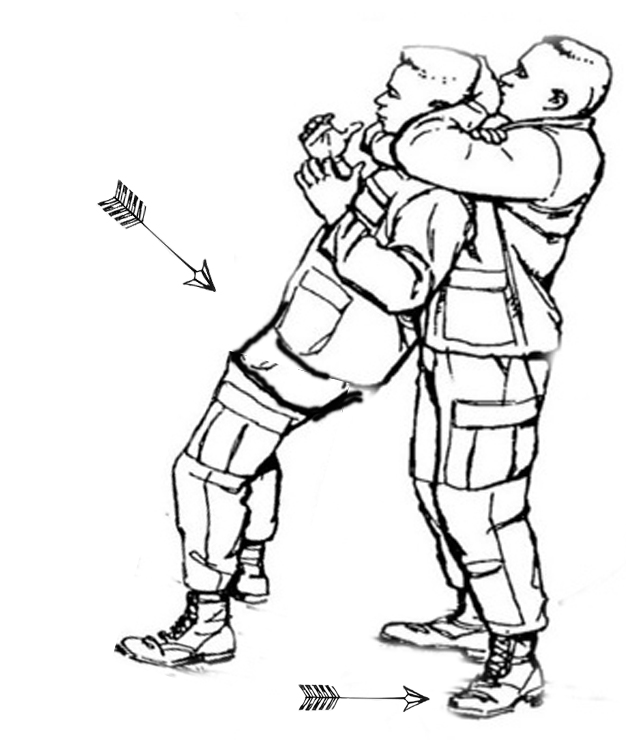 I tell you this to explain the worst-case scenario of what a single arm, (or double arm,) rear neck-wrap takedown can do at its most “bone-damaging.” You can still single or double arm throat pull, slower, and NOT land flat down into this death move, but rather make space and pull him slowly down on his back, with you remaining bent-half-standing or kneeling. Blood choke if you must, but let go at the right instant.
I tell you this to explain the worst-case scenario of what a single arm, (or double arm,) rear neck-wrap takedown can do at its most “bone-damaging.” You can still single or double arm throat pull, slower, and NOT land flat down into this death move, but rather make space and pull him slowly down on his back, with you remaining bent-half-standing or kneeling. Blood choke if you must, but let go at the right instant.
Other related neck structure injuries? I know of a few rather world famous, life-long MMA champs that have stents placed in their trachea due to decades of rough training simulated chokes, and real competition chokes. This operation is called a tracheostomy.
Dr. Earl Morgan, Forensic medicine (and a Judo Black belt) adds…”In all of the combative grappling sports the “choke” hold rules require varying degrees of cervical spine protection. Of course, what makes repetitive chokes in combative grappling so safe (in class) is the health and conditioning of young martial artists. My college judo coach cautioned me to seriously consider allowing chokes in anyone over the age of 40. At the time I was in my 20’s and had no idea what the big deal was. He also spoke of the ‘40-year syndrome.’ This is where you turn 40 and suddenly you have all the aches and pains from all the ways you abused yourself when you were young, whether with drugs, alcohol, athletics, manual labor or other factors, it doesn’t matter. He was a much wiser man than I realized.”
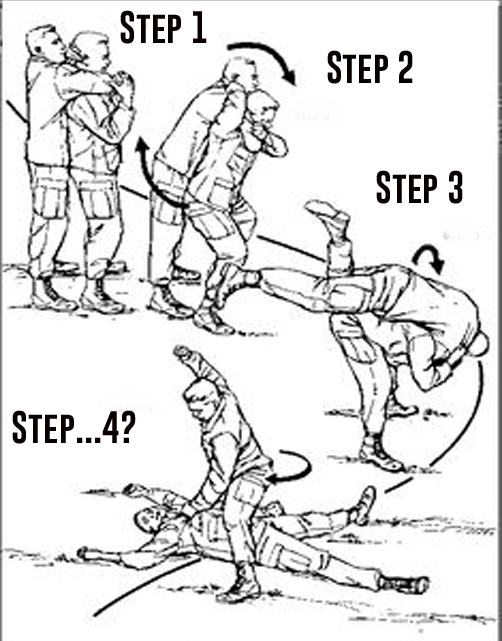 Worrying about the counters… Through the decades in training various counters to chokes and side neck guillotines, I noticed that complying savvy workout partners, always let go of their friend-trainee’s necks when they are flipped or tripped. I don’t think many real-world opponent’s will let go of your neck, instead they reflexively hang on (to anything!) as they lose their balance. This means serious neck cranks, not seen or warned in training class. This innocent-helpful, classroom, “let go” practice leads to misleading and dangerous reality results. There is a lot that can happen between step 3 and step 4, in the drawing to right-above. After issuing similar safety concerns publically about this in the past, I received numerous reports of minor to major injuries from people countering chokes in classes. (I also heard from macho, low I.Q., half-wits denouncing me as a wus. Do they denounce Bass Rutten as a wus too?)
Worrying about the counters… Through the decades in training various counters to chokes and side neck guillotines, I noticed that complying savvy workout partners, always let go of their friend-trainee’s necks when they are flipped or tripped. I don’t think many real-world opponent’s will let go of your neck, instead they reflexively hang on (to anything!) as they lose their balance. This means serious neck cranks, not seen or warned in training class. This innocent-helpful, classroom, “let go” practice leads to misleading and dangerous reality results. There is a lot that can happen between step 3 and step 4, in the drawing to right-above. After issuing similar safety concerns publically about this in the past, I received numerous reports of minor to major injuries from people countering chokes in classes. (I also heard from macho, low I.Q., half-wits denouncing me as a wus. Do they denounce Bass Rutten as a wus too?)
 Even MMA great Bass Rutten wisely warns on record and on film, after demonstrating counter-choke flips like the ones shown on the right and above, that you might break your neck if the choker holds on as he flips. Needless to say a taller, stronger, heavier enemy probably won’t be so easily flipped over you. And, your body drop to flip him over could leave you… “hanging.” All practitioners should examine suggested choke counters for neck safety.
Even MMA great Bass Rutten wisely warns on record and on film, after demonstrating counter-choke flips like the ones shown on the right and above, that you might break your neck if the choker holds on as he flips. Needless to say a taller, stronger, heavier enemy probably won’t be so easily flipped over you. And, your body drop to flip him over could leave you… “hanging.” All practitioners should examine suggested choke counters for neck safety.
Banning chokes...I have been paid by some police agencies through the years to write subject-matter-expert studies on the validity of neck restraints and chokes. In some jurisdictions worldwide police agencies have continued to defend the use of the carotid restraint hold for decades, claiming that it is safer and more effective than using a police baton, taser, or pepper spray. Other jurisdictions have banned its use entirely while still other jurisdictions have ruled that it may only be used in extreme situations where deadly force is justified.
Most enforcement agencies worldwide have banned this “choke’ tactic (or any neck contact for that matter) for many years now. Some allowances exist for when the officer is faced with deadly force. Yet, in a strange Catch-22 circle jerk, these last-resort, life saving choke options are still NEVER TAUGHT, for fear of…being publically seen-caught just teaching the dreaded chokes!
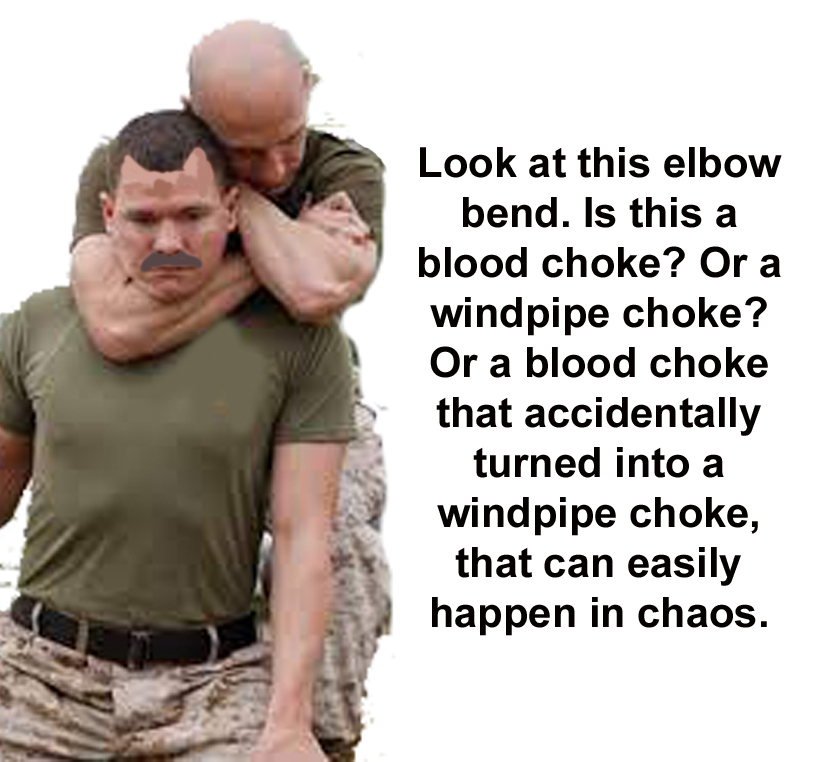 There are some departments that allow these no-choke, neck-grabs and even neck-squeezing controls on unruly suspects and detainees, and a tiny percentage of people continue to suffer temporary and-or grave injury and death. Due to these virtually devastating socio-political problems from these “I can’t breathe” accidental deaths, and due to the rodeo-like wrestling of suspects, a blood choke can often accidentally twist and slip into a throat choke-crush. Because of this slipping mishap, I must warn police administrations against the common use of chokes in less-than-lethal situations. This usually translates to an admin – “leave the whole neck alone unless you are being killed” policy. Don’t blame me for my warning. Train your troops!
There are some departments that allow these no-choke, neck-grabs and even neck-squeezing controls on unruly suspects and detainees, and a tiny percentage of people continue to suffer temporary and-or grave injury and death. Due to these virtually devastating socio-political problems from these “I can’t breathe” accidental deaths, and due to the rodeo-like wrestling of suspects, a blood choke can often accidentally twist and slip into a throat choke-crush. Because of this slipping mishap, I must warn police administrations against the common use of chokes in less-than-lethal situations. This usually translates to an admin – “leave the whole neck alone unless you are being killed” policy. Don’t blame me for my warning. Train your troops!
At least think about this...In a military context, other than when trying to capture prisoners, a choke is a strangulation meant to kill the enemy. But for citizens? These same legal-test concerns hold true for citizens. Civilians must be justified under a reasonable dire threat to windpipe choke someone. If you can’t comprehend the facts here, or be able to consider, discuss, teach and articulate them, you and yours might someday be in moral, ethical and legal (jail and lawsuit) dilemmas.
(This essay on non-choke and choke related neck wraps rear takedowns appear in Level 2 of my Force Necessary:Hand course, thus the essay here, which appears in the outline and my upcoming Unarmed Combatives book in 2024.)


